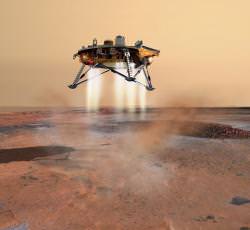I don’t know about your Internet connection, but I have enough trouble wiring up my home network. Imagine trying to connect together spacecraft orbiting millions of kilometres away into a serviceable network. That’s just what’s going to happen when NASA’s Phoenix Lander arrives at the Red Planet. In the spirit of cooperation, ESA’s Mars Express will be on hand to watch the Phoenix lander during its entry and landing phases of the mission.
If everything goes well, Phoenix will blast off from Cape Canaveral on August 4th, making its way to the Red Planet atop a Boeing Delta II rocket. It’ll then take several months to reach Mars, arriving in spring, 2008.
For missions to Mars, the most dangerous moment is the Entry Descent and Landing (EDL) phase, where the spacecraft plunges through the thin Martian atmosphere. Go too fast and you crash into the planet; too slow and you just skip off the atmosphere, and head off into space. For more information about why this is hard, check out this article.
With such a dangerous maneuver, it’s good to know there’ll be another set of eyes watching overhead. Mars Express will optimize its orbit over the next few months so that it’ll be keeping Phoenix directly in sight for the entire EDL phase. Mars Express is equipped with a special electronics package designed to communicate with landers on the surface of Mars. It was originally designed to communicate with Beagle 2, but it’ll be repurposed to talk to Phoenix.
If all goes well, Mars Express will receive regular updates from Phoenix through the decent and landing stages, and then over the lander’s anticipated 90-day lifespan. Let’s hope everything goes well, but if things go poorly, the spacecraft will be able to give mission controllers detailed information about how the lander went splat, so they can work out why. If only Beagle 2 had been so lucky.
Original Source:ESA News Release

